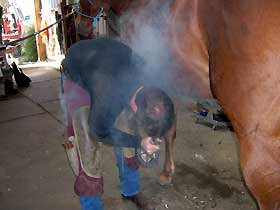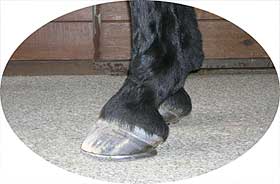My
Approach to Trimming and Shoeing Horses
 First:
An Overall Assessment
First:
An Overall Assessment
To be a good farrier you need to be an experienced clinician, detail- oriented craftsman, and intuitive horse person. One cannot rush, so I pace myself according to my horse-client's current needs.
In
order to provide optimum hoof care, I believe strongly that
each individual horse's whole environment has to be taken
into consideration.
You have to instinctively understand the horse you are working
on; you have to assess the animal's physical condition as
well as his mental state; and you have to give the horse
a chance to develop a sense of trust in you.
My Philosophy
There
are many theories on trimming and shoeing which need to be
considered when you evaluate the condition of a horse's hooves.
When I examine a horse, I select an appropriate method for
this individual horse. "One shoe (or trim) fits
all " is NOT part of my philosophy. If you prescribe
to only one technique as a way to treat every horse, you
loose sight of the individual horse's foot mechanics.
 I
was greatly influenced by Dave Ducket's valuable insight
that good podiatry/ farriery is based on treating each horse
by observing its biomechanics and using the most suited technique
particular to each horse's condition and Michael Savoldi's
path breaking research on uniform
sole thickness.
"As farriers, we need to learn to understand and accept
what the foot is offering. We need to learn to work within
the parameters of what is offered and not attempt to dictate
what we believe the ideal foot would be in order to improve,
develop and maintain a healthy foot." (Savoldi, M.T.
and G.F. Rosenburg, AFA Professional
Farrier, 65, May/June 2003).
I
was greatly influenced by Dave Ducket's valuable insight
that good podiatry/ farriery is based on treating each horse
by observing its biomechanics and using the most suited technique
particular to each horse's condition and Michael Savoldi's
path breaking research on uniform
sole thickness.
"As farriers, we need to learn to understand and accept
what the foot is offering. We need to learn to work within
the parameters of what is offered and not attempt to dictate
what we believe the ideal foot would be in order to improve,
develop and maintain a healthy foot." (Savoldi, M.T.
and G.F. Rosenburg, AFA Professional
Farrier, 65, May/June 2003).
Factors Influencing Shoeing/Trimming Outcomes
When shoeing or trimming a horse there are many factors directly related to the hoof, including:
- conformation of the horse,
- injuries or abscesses,
- pathologies, such as laminitis, founder, navicular and others,
- gait problems, such as forging and interfering,
- behavioral and environmental problems,
- bacteria, fungi, white line disease (WLD) ,and broken down feet.
- expectations of the owner,
- stalls, turnout, arena, trails,
- diet and nutrition,
- amount (and type) of work by the horse and overall condition.
Sometimes it is better to say good-bye than to continue providing services and get frustrated -or maybe even get injured, if the horse has serious behavior problems.
Click here to find out how I evaluate my clients, how I rate them, and how I decide when it's time for me to drop a client.
Pledge to My Clients
I provide quality work on every horse, never rush a job; I continue my education and always strive to improve my skills by attending conferences, seminars and clinics; I stay up to date on the latest procedures and technologies. I'm willing to consult with veterinarians or trainers, if your horse has specific needs.
Last updated December 12, 2012

